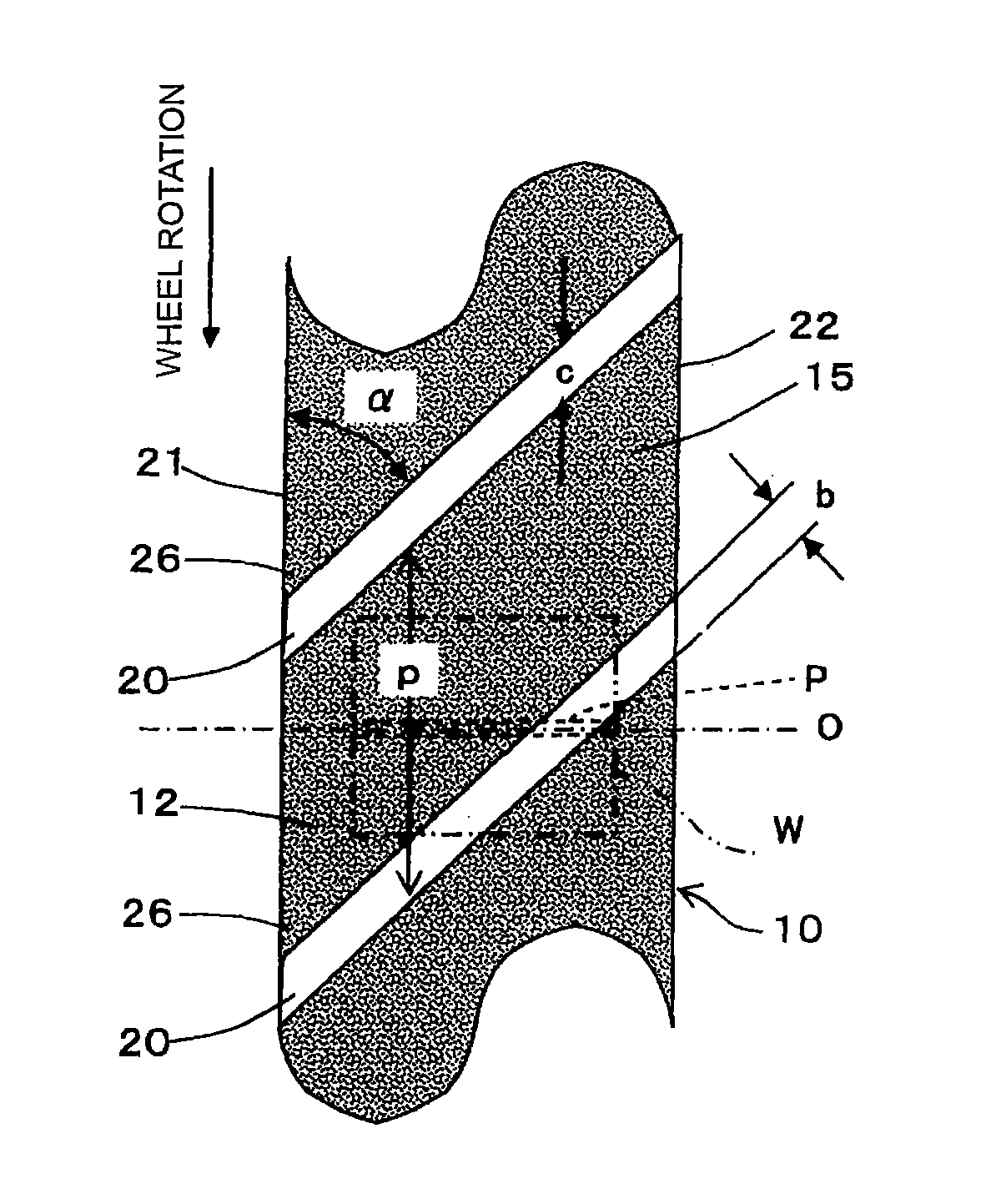Method for manufacturing grinding wheel having depressions on grinding surface thereof
a manufacturing method and technology of grinding wheels, applied in the direction of manufacturing tools, grinding devices, other chemical processes, etc., can solve the problems of easy dropout of superabrasive grains, difficulty in processing inclined grooves or hole-shaped depressions, etc., and achieves high durability, easy manufacturing, and reduced retentivity
- Summary
- Abstract
- Description
- Claims
- Application Information
AI Technical Summary
Benefits of technology
Problems solved by technology
Method used
Image
Examples
first embodiment
[0053]Described hereinafter is a method (the first embodiment) for manufacturing the grinding chip 11 with reference to FIG. 10A. An outer die 41 has a rectangular through cavity. A lower die 42 is fitted in the bottom portion of the through cavity of the outer die 41. A concavity 42a is formed on an upper surface of the lower die 42. The concavity 42a has an arcuate shape corresponding to an arcuate surface of the grinding chip 11 forming an outer periphery of the grinding wheel 10. The outer die 41 and the lower die 42 constitute a press-mold die for molding the grinding chip, and the surface of the concavity 42a constitutes a grinding surface forming surface of the press-mold die for molding the grinding chip. Particles 44 for the abrasive grain layer are put onto the lower die 42 in the outer die 41, and the particles 44 are leveled into uniform thickness (process 51 in FIG. 11). Then, as illustrated in FIG. 10B, a first upper die 45 as a press die is moved downward along the in...
second embodiment
[0066]In the method the inclined grooves 20 are formed on the grinding surface of the grinding chip 11 by press-molding. As illustrated in FIG. 14 and FIG. 15, a lower die 82 is inserted into a bottom portion of a rectangular through cavity that is formed through an outer die 81. An arcuate concavity 82a for press-molding an arcuate surface of a grinding chip 11 is formed on an upper surface of the lower die 82. The arcuate surfaces of grinding chips 11 compose an outer periphery of the grinding wheel 10. A plurality of mounting grooves corresponding to the inclined grooves 20 are formed on the lower die 82. And a plurality of inclined groove forming plates 83 for forming the plurality of inclined grooves are detachably fitted into the mounting grooves, so that the inclined groove forming plates 83 protrude upwardly from the bottom surface of the concavity 82a. The inclined groove forming plates 83 are made of materials such as carbon and are fitted into the mounting grooves to sta...
third embodiment
[0079]According to the method for manufacturing the grinding chip 11 in accordance with the third embodiment, the plurality of hole-shaped depressions 90 are formed on the grinding chip 11 by press-molding. As illustrated in FIG. 19, a lower die 92 is fitted in a bottom portion of a rectangular through cavity formed through an outer die 91. An arcuate concavity 92a for press-molding an arcuate surface of a grinding chip 11 is formed on an upper surface of the lower die 92. The arcuate surfaces of grinding chips 11 compose an outer periphery of the grinding wheel 10. A plurality of mounting holes corresponding to the hole-shaped depressions 90 are formed on the lower die 92. And a plurality of pin members 93 for forming the plurality of hole-shaped depressions are detachably mounted to the mounting holes respectively, so as to protrudes upwardly from the bottom surface of the concavity 92a. The pin members 93 are made of materials such as carbon.
[0080]First, as illustrated in FIG. 19...
PUM
| Property | Measurement | Unit |
|---|---|---|
| thickness | aaaaa | aaaaa |
| thickness | aaaaa | aaaaa |
| thickness | aaaaa | aaaaa |
Abstract
Description
Claims
Application Information
 Login to View More
Login to View More - R&D
- Intellectual Property
- Life Sciences
- Materials
- Tech Scout
- Unparalleled Data Quality
- Higher Quality Content
- 60% Fewer Hallucinations
Browse by: Latest US Patents, China's latest patents, Technical Efficacy Thesaurus, Application Domain, Technology Topic, Popular Technical Reports.
© 2025 PatSnap. All rights reserved.Legal|Privacy policy|Modern Slavery Act Transparency Statement|Sitemap|About US| Contact US: help@patsnap.com



